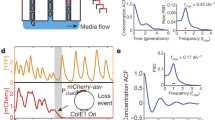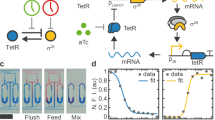Abstract
Synthetic biology has recently provided functional single-cell oscillators. With a few exceptions, however, synchronization across a population has not been achieved yet. In particular, designing a cell coupling mechanism to achieve autonomous synchronization is not straightforward since there are usually several different design alternatives. Here, we propose a method to mathematically predict autonomous synchronization properties, and to identify the network structure with the best performance, thus increasing the feasibility for a successful implementation in vivo.
Our method relies on the reduction of ODE-based models for synthetic oscillators to a phase description, and the subsequent analysis of the phase model either in the spatially homogeneous or heterogeneous case. This analysis identifies three major factors determining if and when autonomous synchronization can be achieved, namely cell density, cell to cell variability, and structural design decisions. Moreover, when considering a spatially heterogeneous medium, we observe phase waves. These waves may hinder synchronization substantially, and their suppression should be considered in the design process.
In contrast to previous work, we analyze the synchronization process of models of experimentally validated synthetic oscillators in mammalian cells. Alternative designs for cell-to-cell communication via a quorum sensing mechanism differ in few mechanistic details, but these differences have important implications for autonomous synchronization. Our analysis suggests that not only the periodical transcription of the protein producing the signaling molecule, but also of the receptor protein is necessary to achieve good performance.
Similar content being viewed by others
References
Acheson, D. J. (1990). Elementary fluid dynamics. London: Oxford University Press.
Atkinson, M. R., Savageau, M. A., Myers, J. T., & Ninfa, A. J. (2003). Development of genetic circuitry exhibiting toggle switch or oscillatory behavior in Escherichia coli. Cell, 113, 597–607.
Brown, E., Moehlis, J., & Holmes, P. (2004). On the phase reduction and response dynamics of neural oscillator populations. Neural Comput., 16, 673–715.
Daniels, B. C. (2005). Synchronization of globally coupled nonlinear oscillators: the rich behavior of the Kuramoto model. Technical report, Ohio Wesleyan University.
Danino, T., Mondragon-Palomino, O., Tsimring, L., & Hasty, J. (2010). A synchronized quorum of genetic clocks. Nature, 463, 326–330.
Elowitz, M. B., & Leibler, S. (2000). A synthetic oscillatory network of transcriptional regulators. Nature, 403, 335–338.
Ferziger, J. H., & Peric, M. (1999). Computational methods for fluid dynamics (2nd ed.). Berlin: Springer.
Fung, E., Wong, W. W., Suen, J. K., Bulter, T., Lee, S., & Liao, J. C. (2008). A synthetic gene-metabolic oscillator. Nature, 435, 118–122.
Garcia-Ojalvo, J., Elowitz, M. B., & Strogatz, S. H. (2004). Modeling a synthetic multicellular clock: repressilators coupled by quorum sensing. Proc. Natl. Acad. Sci., 101(30), 10955–10960.
Gonze, D., Bernard, S., Waltermann, C., Kramer, A., & Herzel, H. (2005). Spontaneous synchronization of coupled circadian oscillators. Biophys. J., 89, 120–129.
Goryachev, A. B., Toh, D. J., & Lee, T. (2006). Systems analysis of a quorum sensing network: design constraints imposed by the functional requirements, network topology and kinetic constants. Biosystems, 83, 178–187.
Koseska, A., Volkov, E., Zaikin, A., & Kurths, J. (2007a). Inherent multistability in arrays of autoinducer coupled genetic oscillators. Phys. Rev. E, 75, 031916–1–031916–8.
Koseska, A., Zaikin, A., Garcia-Ojalvo, J., & Kurths, J. (2007b). Stochastic suppression of gene expression oscillators under intercell coupling. Phys. Rev. E, 75, 031917–1–031917–9.
Kuramoto, Y. (1984). Chemical oscillations, waves and turbulence. Berlin: Springer.
Kuramoto, Y., & Nishikawa, I. (1987). Statistical macrodynamics of large dynamical systems. Case of a phase transition in oscillator communities. J. Stat. Phys., 49, 569–605.
Kuznetsov, A., Kaern, M., & Kopell, N. (2004). Synchrony in a population of hysteresis-based genetic oscillators. SIAM J. Appl. Math., 65(2), 392–425.
Li, C., Chen, L., & Aihara, K. (2007). Stochastic synchronization of genetic oscillator networks. BMC Systems Biology, 1(6).
Locke, J. C. W., Westermark, P. O., Kramer, A., & Herzel, H. (2008). Global parameter search reveals design principles of the mammalian circadian clock. BMC Systems Biology, 2(22).
McMillen, D., Kopell, N., Hasty, J., & Collins, J. J. (2002). Synchronizing genetic relaxation oscillators by intercell signaling. Proc. Natl. Acad. Sci., 99(2), 679–684.
Misra, J. C., & Mitra, A. (2008). Synchronization among tumour-like cell aggregations coupled by quorum sensing: a theoretical study. Comput. Math. Appl., 55, 1842–1853.
Müller, J., Kuttler, C., Hense, B. A., Rothballer, M., & Hartmann, A. (2006). Cell–cell communication by quorum sensing and dimension-reduction. J. Math. Biol., 53, 672–702.
Patankar, S. V., & Spalding, D. B. (1971). A calculation procedure for heat, mass and momentum transfer in three-dimensional parabolic flows. Int. J. Heat Mass Transf., 15, 1787–1806.
Preitner, N., Damiola, F., Lopez-Molina, L., Zakany, J., Duboule, D., Albrecht, U., & Schibler, U. (2002). The orphan nuclear receptor REV-ERBα controls circadian transcription within the positive limb of the mammalian circadian oscillator. Cell, 110, 251–260.
Rosenblum, M., Pikovsky, A., Kurths, J., Schafer, C., & Tass, P. A. (2001). Handbook of biological physics (Vol. 4, pp. 279–321). Amsterdam: Elsevier. Chapter 9.
Russo, G., & di Bernardo, M. (2009). How to synchronize biological clocks. J. Comput. Biol., 16(2), 379–393.
Sewell, G. (2005). The numerical solution of ordinary and partial differential equations. New York: Wiley.
Shiner, E., Reddy, S., Timmons, C., Guigen, L., Williams, S., & Rumbaugh, K. (2004). Construction of a bacterial autoinducer detection system in mammalian cells. Biol. Proced. Online, 6(1), 268–276.
Stricker, J., Cookson, S., Bennett, M. R., Mather, W. H., Tsimring, L. S., & Hasty, J. (2008). A fast, robust and tunable synthetic gene oscillator. Nature, 456, 516–520.
Strogatz, S. H. (2000). From Kuramoto to Crawford: exploring the onset of synchronization in populations of coupled oscillators. Physica D, 143, 1–20.
Taylor, A. F., Tinsley, M. R., Wang, F., Huang, Z., & Showalter, K. (2009). Dynamical quorum sensing and synchronization in large populations of chemical oscillators. Science, 323, 614–617.
Tigges, M., Marquez-Lago, T. T., Stelling, J., & Fussenegger, M. (2009). A tunable synthetic mammalian oscillator. Nature, 457, 309–312.
Wang, W., & Slotine, J. J. (2005). On partial contraction analysis for coupled nonlinear oscillators. Biol. Cybern., 92(1), 38–53.
Waters, C. M., & Bassler, B. L. (2005). Quorum sensing: cell-to-cell communication in bacteria. Annu. Rev. Cell Dev. Biol., 21, 319–346.
Winfree, A. T. (1967). Biological rhythms and the behavior of populations of coupled oscillators. J. Theor. Biol., 16, 15–42.
Zhou, T., Zhang, J., Yuan, Z., & Chen, L. (2008). Synchronization of genetic oscillators. Chaos, 18, 037126-1–037126-20.
Author information
Authors and Affiliations
Corresponding authors
Electronic Supplementary Material
Below are the links to the electronic supplementary material.
AHL During Synchronization (MOV 14.525 kB)
Phases During Synchronization (MOV 3.338 kB)
Rights and permissions
About this article
Cite this article
Lang, M., Marquez-Lago, T.T., Stelling, J. et al. Autonomous Synchronization of Chemically Coupled Synthetic Oscillators. Bull Math Biol 73, 2678–2706 (2011). https://doi.org/10.1007/s11538-011-9642-8
Received:
Accepted:
Published:
Issue Date:
DOI: https://doi.org/10.1007/s11538-011-9642-8




